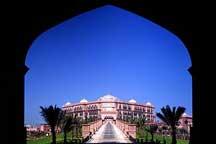 May. 10, 2025
May. 10, 2025
Weather
Beijing's proportion of tertiary industry ranks No.1 in China
2009-09-03 16:38 BJT
Beijing Municipal Commission of Development and Reform said on September 1 that in 2008, the tertiary industry accounted for 73.2 percent of Beijing's GDP, a significant rise compared to 23.7 percent at the early stage of the reform and opening up. Currently, the proportion of Beijing’s tertiary industry ranks the first in China, indicating that Beijing’s industrial structure has changed from being industry-dominated to being service-dominated.
Since the reform and opening-up and with urban planning revisions and gradually defined functions of the capital, Beijing began to accelerate the upgrading and adjustment of its industrial structure. In 1994, the proportion of the service industry surpassed that of the secondary sector, forming a hierarchy with the tertiary industry at the top, followed by the secondary and primary industries. In 1995, the proportion of the service industry exceeded 50 percent, marking that Beijing had gradually developed into a tertiary industry-leading city from a major national industrial base. After that, the proportion of the tertiary industry in Beijing continued to rise, surpassing 60 percent in 1998 and 70 percent in 2006, and reaching 73.2 percent in 2008.
The service-dominated industrial structure with characteristics of the capital has taken its initial shape in Beijing. According to an official from Beijing Municipal Commission of Development and Reform, the service-dominated economy has not only enhanced the urban carrying capacity and upgraded the city’s service functions, but also helped control fluctuations in the economy. In particular, it has served as a stabilizer under the international financial crisis and the worldwide economic recession.
Within Beijing’s industries there is an increasingly apparent high-end tendency. With the industry promoted by scientific and technological advancement and informatization, the manufacturing industry has moving fast towards a high-end industry.
Reporters learned that since 2002, the competitiveness and intensive development level of Beijing’s manufacturing industry have been further upgraded and a batch of modern manufacturing projects such as Semiconductor Manufacturing International Corp. (SMI), TFT of BOE Technology Group Co, Hyundai Motors, Shougang Group cold rolling, Mercedes-Benz and Corning glass substrate have all been put into operation. In 2008, the modern manufacturing industry in Beijing generated added value of 83.27 billion yuan, accounting for 37.9 percent of the total industrial added value.
At the same time, Beijing is accelerating the relocating and transforming of industries that are inconsistent with the capital’s functions. It has carried out the adjustment and relocation of Shougang Group in an orderly manner, closed down several enterprises such as Beijing Coking Plant, Beijing Organic Chemical Plant and Beijing Hua Er Co., and eliminated such industries as the small-scale paper-making industry, small-scale printing and dyeing industry as well as small-scale foundry industry, and has also eliminated backward technologies and equipment.
As for tertiary industry, a modern service industry system has taken its preliminary shape and has become a major force propelling the fast development of Beijing’s economy. In 2008, the modern service industry in Beijing generated an added value of 535.89 billion yuan, accounting for 51.1 percent of Beijing’s total output value. Producer service industries including finance, information services, scientific and technological research and development, as well as commerce services have sped up, and knowledge, capital and technology-intensive features are becoming increasingly prominent.
Translated by LOTO
Editor: Shi Taoyang | Source: CCTV.com Mail
Mail Share
Share Print
Print


 Video
Video









 2009 China Central Television. All Rights Reserved
2009 China Central Television. All Rights Reserved